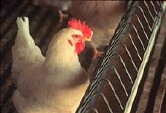- Navigating Your Midlife Crisis: Embracing New Possibilities
- City Raccoons Showing Signs of Domestication
- Mapping the Exposome: Science Broadens Focus to Environmental Disease Triggers
- One Week Less on Social Media Linked to Better Mental Health
- Your Brain Changes in Stages as You Age, Study Finds
- Some Suicide Victims Show No Typical Warning Signs, Study Finds
- ByHeart Formula Faces Lawsuits After Babies Sickened With Botulism
- Switch to Vegan Diet Could Cut Your Greenhouse Gas Emissions in Half
- Regular Bedtime Does Wonders for Blood Pressure
- Dining Alone Could Mean Worse Nutrition for Seniors
5.3 Million Chickens To Be Killed After Bird Flu Outbreak at Iowa Farm


Bird flu has been detected on an Iowa farm with a flock of about 5 million chickens, bringing the total number of chickens and turkeys affected by the virus to nearly 8 million nationwide.
All of the birds on farm will be killed, the Wall Street Journal reported.
Experts at the U.S. Department of Agriculture stressed that no human cases of bird flu have occurred in the United States and the virus poses a low risk to people.
Another expert agreed.
“Although the bird flu can be quite virulent, the main virus in question — H5N2 — does not constitute an immediate threat to the safety of the public or the food supply in general,” said Dr. Robert Glatter, an emergency physician at Lenox Hill Hospital in New York City.
The Iowa farm newly hit by bird flu is in Osceola County, but wasn’t named by officials. The Iowa Poultry Association said the farm supplies eggs for eating and processing, and that all eggs from the farm have been collected and quarantined.
“In very rare instances, the virus can jump to humans,” Glatter said, but “in this setting, H5N1 [not H5N2] would be the most concerning strain.”
He also noted that the majority of cases of avian flu in humans “are actually traced to persons who have had contact with poultry.”
“Overall, while it is possible for humans to contract flu from animals or birds, the risk is quite low,” Glatter said.
The bird flu outbreak began late last year and is the worst in years. In the past two weeks, there has been a sharp rise in the number of cases in Midwest states such as Iowa, Minnesota and Wisconsin, the WSJ reported.
Officials said they don’t know when the disease might stop spreading. In an effort to contain it, all birds in flocks where bird flu is confirmed will be destroyed.
It’s believed that the bird flu virus is carried by wild ducks and geese, and that the virus is spread through their droppings, which are unknowingly tracked into poultry farms by workers, the WSJ reported.
More information
There’s more on avian flu at the U.S. Centers for Disease Control and Prevention.
Source: HealthDay
Copyright © 2025 HealthDay. All rights reserved.










